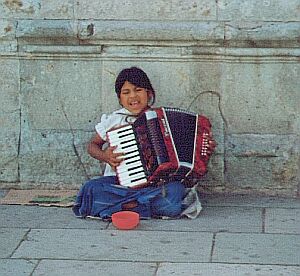Home >>
Oaxaca >>
Oaxaca, Oaxaca >>
An Expatriate Life >>
Letters >>
The Servant
[When this letter first appeared, in the fall of 1994, I did not have any personal knowledge regarding the practices outlined here; nor do I now. I introduced this subject because there had been persistently recurring stories in the Mexican press in reference to buying - and stealing - children.]
The woman is dressed in a simple smock, plastic slippers, and a kerchief. Her skin is the color of a walnut, and she has bruises around her mouth. She is perhaps 30 years old, but it is hard to tell. Her life has aged her in ways that are confusing to Gringo eyes.

This girl has been sitting here for months, all day long, belting out traditional songs in hopes of earning enough to eat. Perhaps she has a family nearby, perhaps not. Perhaps she is forced to share her earnings with someone else, perhaps not. One thing is sure: she, like a lot of her compatriots of the streets, has had very little time to be a child.
[Photo by Diana Ricci]
|
She is supporting an older woman as they stroll unnoticed past the people in the sidewalk cafes. The older woman, dressed in brightly patterned silk, has white skin. Her lips are thin and straight, as is her nose. Her eyes are blue. Her fingers sparkle with jewelry, and she has an ornately carved cane in her other hand as she leans on her companion. They walk slowly. Perhaps the younger woman is her daughter or granddaughter. Perhaps she is a servant. Perhaps she is a slave.
Many believe that slavery still exists in Mexico, as it has for thousands of years. In ancient times, when tribes fought each other, it was common for the victors to enslave the vanquished. In modern times the battles are economic, but in some cases the results are the same.
I have been told that some Zapotec families, living in primitive conditions in the mountains of Oaxaca, are so poor that they sell their children. The going rate, according to my informant, is between $10 and $20 thousand dollars, depending on the color of the child, and whether the purchaser is a foreigner. The highest prices are fetched for children whose fathers are Blancos, and adopted by Gringos who cannot have children of their own. I am told that in certain villages, a wandering Gringo can have his pick of young women to sleep with, in hopes that the union will produce a child of "high value". Of course the local young men are resentful, but what can you do? Economics, amigo!
The lucky kids get adopted by people who want a child to love, protect, and raise as their own. They are generally taken young -- about four to six months old. The unlucky ones get sold to pedophiles or pimps. The ones whose luck falls in between get "adopted" at around age eight or nine, and trained to serve. Some get taken in by kindly people, who do not beat them, and allow them to obtain an education. Some do not. With the kind of realism generated by unrelenting poverty, many consider themselves better off in either case.
Buying and selling children is illegal in Mexico. Adoption is not. Therefore, documentation is required. Letters of intent, powers of attorney, certificates of birth, contracts for adoption, and other official documents must be obtained. Taxes must be paid. Notaries, judges, mayors and priests must stamp, sign, draft and file numerous documents. It would all be very difficult without the services of an attorney. Fortunately for all concerned (except perhaps the adoptee), attorneys are readily available to be of assistance, for a fee.
Mexico is a third-world country. Much of rural Mexico is poor beyond the comprehension of the average first-worlder. "In the mountains", a missionary told me with some bitterness, "the chief product is children". Some of the kids who sell chiklets in the Zócalo (town square), or beg for bread in the streets, simply have no home. They were abandoned by a family who could no longer feed them. Many more are abandoned at birth by mothers who are themselves children. Some die. Some are taken in by orphanages run by the Catholic Church. Some are rescued by volunteer agencies --often staffed by medical professionals -- and put up for legitimate adoption at no charge.
One gets the feeling that many people have heard about the problem. Few are willing to discuss it, and among those few there is little consensus about a solution. Mexicans -- mestizo and indigenous -- love kids. They do the best they can with the little that they have. A rural-economist friend says it's unlikely that things will change much unless the economic realities change, however well-intentioned the authorities are -- and he expects things to get worse before they get better. "As the disparity between the affluent urban professional class and the rural poor continues to increase, I am afraid that more Indian villages will become baby farms".
(August, 1994)
| Top of page |
